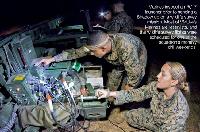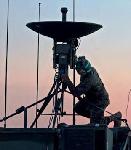Фотографии
-
This image shows to good effect the type of terrain VMU-4 has to contend with while operating out of the HOLF. While undeniably scenic, Camp Pendleton's large hills force the RQ-7B to higher altitudes to maintain electronic line-of-sight with the ground control station. In the foreground are two of VMU-4's ground control station vehicles. The GCS is effectively the ‘cockpit’ of the RQ-7.
Самолёты на фотографии: AAI RQ-7 Shadow - США - 1992
-
VMU-4 is the last operator of the AAI RQ-7B Shadow UAS in the US Marine Corps, and will begin transitioning to the Boeing-Insitu RQ-21A Blackjack early next year. The wildlife survey missions flown in August 2017 were actually the squadron's penultimate flight operation with the Shadow.
Самолёты на фотографии: AAI RQ-7 Shadow - США - 1992
-
A ‘short-wing’ RQ-7B awaits assembly at the HOLF. With six hours endurance and Camp Pendleton’s ranges only a short flight away, VMU-4 typically opts for the short-winged Shadows for local missions, versus the long-winged variant, which offers nine hours endurance. Capabilities between the two are the same, only the long-wing RQ-7 takes longer to defuel after shorter missions.
Самолёты на фотографии: AAI RQ-7 Shadow - США - 1992
-
The Shadow’s primary payload is the IAI POP300 electro-optical/ infrared sensor turret, equipped with a laser designator. The POP300 can generate ten-digit target coordinates, precise enough for GPS-guided weapons, but also useful for other functions, like pinpointing where a southern mule deer was spotted.
Самолёты на фотографии: AAI RQ-7 Shadow - США - 1992
-
Marines inspect an RQ-7 launcher prior to sending a Shadow up on a wildlife survey mission. Most of VMU-4's Marines are reservists, and the wildlife survey flights were scheduled for one of the squadron’s monthly drill weekends.
Самолёты на фотографии: AAI RQ-7 Shadow - США - 1992
-
One of VMU-4’s Marines inspects the main antenna on a ground control station prior to a night-time wildlife survey mission.
Самолёты на фотографии: AAI RQ-7 Shadow - США - 1992
-
A typical RQ-7B crew consists of an air vehicle operator (left) who flies the aircraft, a mission payload operator (right) who operates the sensors and communications payloads, and an unmanned aircraft commander (UAC, not pictured), an officer in a nearby command centre. The UAC is often accompanied by an intelligence specialist assigned to the squadron. On this flight, the UAC was accompanied by game wardens and wildlife biologists. Instructors often sit in on RQ-7B flights, which is the case with the Marine pictured at far left in this image.
Самолёты на фотографии: AAI RQ-7 Shadow - США - 1992
-
The second survey flight of the weekend was cancelled when clouds moved into the area almost immediately after the RQ-7B for this mission was launched. Looking at the mission payload operator’s screen, it is clear just how thoroughly these clouds obscure the ground.
Самолёты на фотографии: AAI RQ-7 Shadow - США - 1992
Статьи
- Advertisements
- Airscene
- D.Isby - F-35 Lightning II Starting Worldwide Sustainment /Military/
- D.Isby - KC-46A Pegasus Sprinting Over Hurdles towards Delivery /Military/
- D.Isby - New from St. Louis: Boeing's F-15QA Eagle and Block III Super Hornet /Military/
- D.Isby - The Business End: Tankers and their Air Refuelling Systems /Military/
- D.Isby - View from the Cockpit: F-15E Strike Eagle /Military/
- D.Sipinski - Baltic Connection /Commercial/
- D.Sipinski - New Allies, Old Issues /Commercial/
- J.Copalman - Counting Sheep. VMU-4's Marines Take a Walk on the Wild Side /Military/
- J.Gunner - Gripen E. The Story So Far /Military/
- J.Lake - Genesis of the Swordfish /Military/
- L.Mennes, F.Visser - Dutch Drakens /Military/
- M.Ayton - Scorpion's Coming of Age /Military/
- M.Broadbent - Going Solo /Commercial/
- M.Clements - Green Hornets and the Super Hercules /Military/
- N.Pittaway - Cutting Edge ASW. Australia's Naval Combat Helicopter /Military/
- N.Pittaway - The Smart Tanker /Military/







